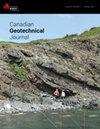中高密度软泥晶:微观结构特征对状态和压缩性的影响
IF 3.5
3区 工程技术
Q2 ENGINEERING, GEOLOGICAL
引用次数: 0
摘要
通过在水中的长时间搅拌,将马耳他中Globigerina灰岩(MGL)的3个矿物组成和指标性质与某些中高密度白垩相相似的软岩相进行分解,得到了重构样品。其粘土大小的方解石颗粒的显著活性可以赋予中高塑性。天然样品和重建样品的扫描电镜分析表明,自然结合是连锁的,可能是由粘土大小的方解石颗粒在沉积物压实过程中凝聚引起的。微观分析和压缩试验数据也表明,埋藏下局部方解石晶体的过度生长进一步降低了软岩孔隙度,使其低于一维压缩到地质预固结压力下的重构材料的孔隙度。尽管如此,天然MGL的低应力敏感性表明,相对于高度压缩的重构土,这种互锁结合并没有加强多少材料。天然MGL的渗透率非常低,随着压缩进一步降低。同时,软岩蠕变系数增大,达到远高于典型粘土的数值。不同MGL相的显微结构特征和力学性质对粘土矿物含量敏感。本文章由计算机程序翻译,如有差异,请以英文原文为准。
Medium-high density soft micrites: Impact of microstructural features on state and compressibility
Three soft rock facies of the Middle Globigerina Limestone (MGL) from Malta, of mineralogical composition and index properties similar to some medium-high density Chalk facies, are disaggregated through prolonged agitation in water, to create reconstituted samples. The significant activity of their clay-sized calcite grains can impart a medium-high plasticity. SEM analyses of natural and reconstituted samples show the natural bonding as interlock, possibly induced by cohesive clay-sized calcite grains during the sediment compaction. Micro-analyses and compression test data also show that local calcite crystal over-growth under burial has reduced further the soft rock porosity, making it lower than that of the reconstituted material one-dimensionally compressed to the geological preconsolidation pressure. Nonetheless, the low stress sensitivity of natural MGL suggests that this interlock bonding does not strengthen much the material with respect to the highly compressed reconstituted soil. The natural MGL is of very low permeability, which reduces further with compression. Concurrently, the soft rock creep coefficient increases, reaching values far above those typical for clays. The microstructural features and the mechanical properties of the different MGL facies are shown to be sensitive to clay mineral content.
求助全文
通过发布文献求助,成功后即可免费获取论文全文。
去求助
来源期刊

Canadian Geotechnical Journal
地学-地球科学综合
CiteScore
7.20
自引率
5.60%
发文量
163
审稿时长
7.5 months
期刊介绍:
The Canadian Geotechnical Journal features articles, notes, reviews, and discussions related to new developments in geotechnical and geoenvironmental engineering, and applied sciences. The topics of papers written by researchers and engineers/scientists active in industry include soil and rock mechanics, material properties and fundamental behaviour, site characterization, foundations, excavations, tunnels, dams and embankments, slopes, landslides, geological and rock engineering, ground improvement, hydrogeology and contaminant hydrogeology, geochemistry, waste management, geosynthetics, offshore engineering, ice, frozen ground and northern engineering, risk and reliability applications, and physical and numerical modelling.
Contributions that have practical relevance are preferred, including case records. Purely theoretical contributions are not generally published unless they are on a topic of special interest (like unsaturated soil mechanics or cold regions geotechnics) or they have direct practical value.
 求助内容:
求助内容: 应助结果提醒方式:
应助结果提醒方式:


